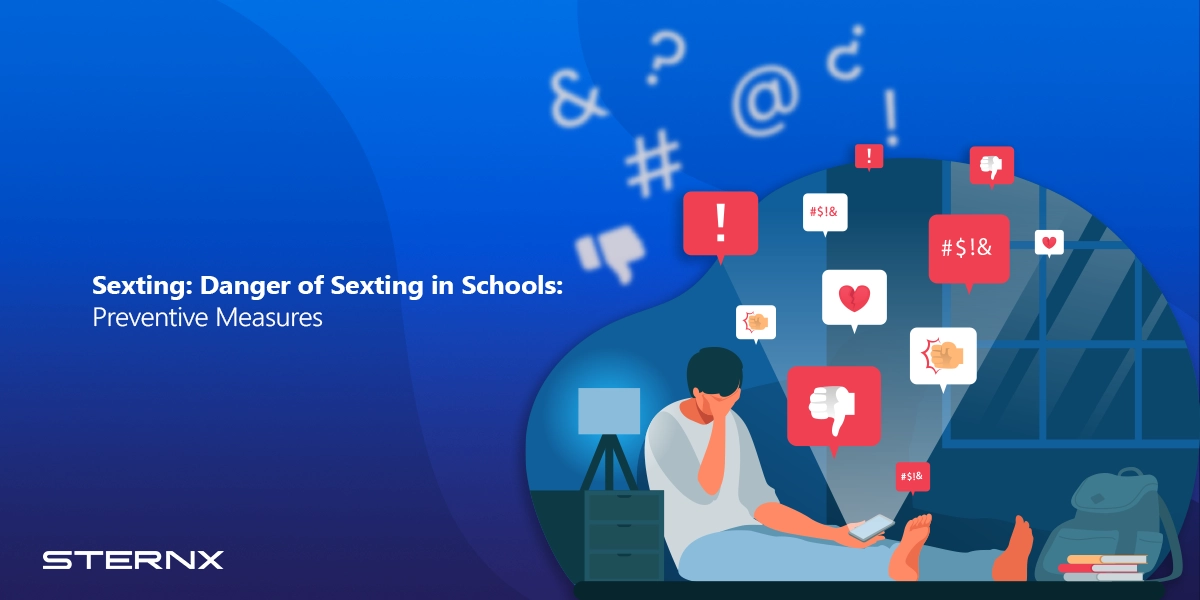In the age of technology and social media, the dangers of sexting in schools among students have become a growing concern for educators, parents, and the community. Sexting, the act of sending or receiving sexually explicit or semi-nude images, messages, or videos through electronic devices, has become prevalent among teenagers. While it may seem harmless or even alluring, the consequences of sexting can be devastating, affecting students’ mental health, safety, and future prospects.
It is crucial to address this issue proactively and provide students with guidance, education, and resources to navigate the digital world safely.
Table of Contents
ToggleUnderstanding Sexting and Its Forms:
The act of sexting involves the exchange of sexual images, videos, or messages through smartphones and social media. This behavior is becoming increasingly common among teenagers, who share intimate and explicit sexual content without considering the potential negative and risky outcomes. Recent studies indicate that sexting is closely linked to individuals’ self-esteem and the impact of social media on their behavior.
Sexting can take various forms, including sharing nudes and semi-nudes photographs, explicit text messages, or videos. It can occur through various platforms, such as social media platforms, messaging services, or even email. Some students may engage in sexting voluntarily, while others may be coerced, manipulated, or even blackmailed into participating.
Tools Used in Sexting
Students have a plethora of tools at their disposal for engaging in sexting. Here are some common students sexting tools used by students in sexting:
- Messaging Apps: Apps like WhatsApp, Snapchat, and Kik provide private and instantaneous communication, making them popular choices for sharing intimate messages and images.
- Social Media Platforms: Platforms such as Instagram, Twitter, and Facebook offer direct messaging features, allowing for discreet conversations and potential sexting.
- Photo-sharing Services: Services like Snapchat and Instagram allow users to exchange photos and videos, often with the expectation of temporary visibility, which can facilitate sexting.
- Traditional Mediums: Even traditional mediums like texting with cell phone and email are frequently utilized for sexting due to their widespread availability and ease of use.
The Consequences of Sexting in Schools:
The dangers of sexting in schools can have severe consequences for students, including:
- Legal Repercussions: Depending on the jurisdiction, sexting involving minors can be considered child pornography, which is a criminal offense. Students involved in sexting could face legal charges, fines, or even registration as sex offenders.
- Emotional and Psychological Harm: Teen sexting can lead to bullying, harassment, and cyberbullying, which can have a profound impact on a student’s mental health. The shame, embarrassment, and anxiety associated with having explicit content shared without consent can cause depression, low self-esteem, and even suicidal thoughts.
- Reputation Damage: Once a person receive a sext content and is shared online, it can be challenging to remove or control its spread. This can lead to long-lasting damage to a student’s personal information and reputation affecting their future educational and career opportunities.
- Risk of Sexual Exploitation: Sexting images or videos can be shared without consent, potentially exposing students to sexual predators or exploitation.
The Dangers of Sexting and Student Mental Health:
Sexting can have a significant impact on a student’s mental health, leading to various emotional and psychological issues. Some of the dangers include:
- Anxiety and Depression: The fear of having intimate content shared without consent can cause severe anxiety and depression in students, affecting their academic performance and overall well-being.
- Low Self-Esteem and Body Image Issues: The pressure to conform to societal beauty standards and the potential for body-shaming can contribute to low self-esteem and negative body image among students involved in sexting.
- Cyberbullying and Harassment: Sexting content can be used as a tool for bullying and harassment, leading to social isolation, emotional distress, and even self-harm.
- Trauma and Post-Traumatic Stress Disorder (PTSD): In severe cases, the emotional and psychological impact of sexting can lead to trauma and PTSD, which can have long-lasting effects on a student’s mental health and well-being.
Online Safety Tips for Students to Avoid Sexting:
To prevent the dangers of sexting and promote online safety, it is essential to educate students on responsible internet safety and digital behavior. Here are some sexting information for students:
- Think Before You Share: Remind students that once a nude photo or video is shared, it can be nearly impossible to control its spread or remove it entirely.
- Set Boundaries: Encourage students to communicate their boundaries clearly and respect the boundaries set by others.
- Seek Support: If students feel pressured or coerced into sexting or any sexual activity, encourage them to seek help from trusted adults, counselors, or authorities.
- Strengthen Privacy Settings: Educate students on how to strengthen their privacy settings on social media and messaging apps to limit potential exposure.
- Be Cautious of Strangers: Warn students about the dangers of interacting with or sharing explicit content with strangers, as they could be potential predators.
Role of Teachers and Educational Institutions:
Teachers and educational institutions play a crucial role in addressing the issue of sexting and promoting online safety by implementing classroom management software and mobile device management in schools . Here are some strategies they can implement on how to talk to teens about sexting:
Comprehensive Education:
Provide age-appropriate education on sexting, online safety, and responsible digital behavior through school curricula, workshops, or guest speakers.
Clear Policies and Consequences:
Establish clear rules and consequences for sexting in school. This will help students understand the seriousness of the issue and the potential legal and disciplinary outcomes. Ensure that you clearly communicate the rules to all students. Enforce the consequences consistently to deter students from engaging in sexting behavior.
Promote open communication: Create a safe space for students to discuss sensitive issues. Students can get support from trusted adults such as teachers, family members, counselors, or administrators.
Collaborate with Parents and Guardians:
Engage parents and guardians in the conversation, providing them with resources and guidance on how to discuss online safety and sexting with their children.
Implement Monitoring and Filtering Solutions:
Utilize classroom management software and filtering solutions to monitor and restrict access to inappropriate content on school devices and networks.
Introducing SternX Technology’s Solution:
SternX Technology offers a comprehensive solution to help educational institutions and parents protect children and address dangers of sexting in schools. Their free classroom management software and parental control app includes advanced monitoring and filtering capabilities, enabling teachers and administrators to:
- Monitor Student Activity: Track and log student activity on school devices and networks, allowing for early detection of potential sexting incidents.
- Filter Explicit Content: Block access to websites, apps, and content containing explicit or inappropriate material, reducing the risk of sexting and exposure to harmful content.
- Keyword Alerts: Set up customizable keyword alerts to detect and flag potentially dangerous or explicit language used in text messages, emails, or documents.
- Remote Management: Remotely manage and control student devices, enabling immediate intervention and prevention of sexting incidents.
- Incident Reporting and Documentation: Generate detailed reports and maintain comprehensive documentation of sexting incidents, ensuring proper handling and follow-up.
By implementing Sternx Technologies solution, educational institutions can proactively address the dangers of sexting in schools, promote online safety, and maintain a secure and responsible digital environment for students.
Conclusion:
Sexting in schools is a complex and sensitive issue that requires a multifaceted approach. By educating students on the dangers of sexting, fostering open communication, implementing clear policies, and utilizing technological solutions like SternX Technology’s classroom management software, educational institutions can create a safer and more responsible digital environment. It is crucial to address the dangers of sexting in schools proactively, protecting students’ mental health, safety, and future prospects while promoting responsible digital citizenship.


